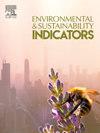Assessing provincial inter-provincial carbon flow and economic inequality in China's construction industry
IF 5.4
Q1 ENVIRONMENTAL SCIENCES
引用次数: 0
Abstract
Inter-regional trade leads not only to the movement of goods and economies, but also to the shifting of emissions. As one of the largest emitters in China, the carbon flow and economic inequality in the construction industry due to inter-provincial trade need to be further investigated, which is essential for developing sustainable models. Based on various data sources, this study applied the emission coefficient method, multi-regional input-output analysis, and carbon inequality index to investigate the inter-provincial transfer of carbon emissions within China's construction industry. This study found, there are substantial disparities in the embodied flows of carbon emissions and the economic benefits across provinces, with a high concentration of emissions in the northern coastal regions. Henan stands out as the province with the highest carbon emissions supporting its own development, with 172.09 104 t and importing the largest economic benefit,5732.89 billion yuan,. Zhejiang is the biggest contributor, of 40.92 104 t and 969.30 billion yuan, respectively. Additionally, the study reveals a significant correlation between net carbon emissions transfer and GDP per capita. Regions in the southeast and northeast generate higher economic output per unit of carbon emissions from the Construction Industry, in contrast to the northwest and southwest, where severe carbon inequality persists. These results highlight the need for reductions in embodied carbon emissions within the construction Industry and the implementation of carbon compensation mechanisms. This study can also serve as a reference for other emerging nations confronting similar challenges of carbon inequality and the pursuit of sustainable regional development models.
中国建筑行业省际碳流与经济不平等评价
区域间贸易不仅导致商品和经济的流动,也导致排放的转移。建筑业作为中国最大的排放产业之一,其省际贸易导致的碳流和经济不平等问题需要进一步研究,这对构建可持续发展模型至关重要。本研究基于多种数据来源,运用排放系数法、多区域投入产出分析法和碳不平等指数对中国建筑业碳排放的省际转移进行了研究。研究发现,各省间碳排放隐含流量和经济效益存在较大差异,北方沿海地区碳排放集中度较高。河南省以172.09 × 104吨的碳排放量和57328.9亿元的经济效益,成为支持自身发展碳排放量最大的省份。浙江是最大的贡献者,分别为4092 × 104吨和9693亿元。此外,研究还揭示了净碳排放转移与人均GDP之间的显著相关性。东南和东北地区建筑业单位碳排放的经济产出更高,而西北和西南地区则存在严重的碳不平等。这些结果强调了减少建筑行业隐含碳排放和实施碳补偿机制的必要性。本研究也可以为其他面临类似碳不平等挑战和追求区域可持续发展模式的新兴国家提供参考。
本文章由计算机程序翻译,如有差异,请以英文原文为准。
求助全文
约1分钟内获得全文
求助全文
来源期刊

Environmental and Sustainability Indicators
Environmental Science-Environmental Science (miscellaneous)
CiteScore
7.80
自引率
2.30%
发文量
49
审稿时长
57 days
 求助内容:
求助内容: 应助结果提醒方式:
应助结果提醒方式:


